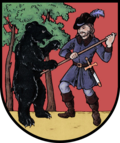Bystré u Poličky
| Bystré | ||||
|---|---|---|---|---|
|
||||
| Basic data | ||||
| State : |
|
|||
| Region : | Pardubický kraj | |||
| District : | Svitavy | |||
| Area : | 1409 ha | |||
| Geographic location : | 49 ° 38 ' N , 16 ° 21' E | |||
| Height: | 604 m nm | |||
| Residents : | 1,540 (Jan 1, 2019) | |||
| Postal code : | 569 92 | |||
| License plate : | E. | |||
| traffic | ||||
| Street: | Polička - Olešnice | |||
| structure | ||||
| Status: | local community | |||
| Districts: | 2 | |||
| administration | ||||
| Mayor : | Jan Neudert (as of 2019) | |||
| Address: | nám. Na podkově 2 569 92 Bystré u Poličky |
|||
| Municipality number: | 577928 | |||
| Website : | www.bystre.cz | |||
Bystré (German Bistrau ) is a city in the Czech Republic . It is located eleven kilometers southeast of Polička in the mountains of the Upper Swratka and belongs to the Okres Svitavy .
geography
Bystré is located on the upper reaches of the Bysterský potok. Neighboring towns are Dolní Jedlová and Čtyří Dvory in the north, Hamry nad Křetínkou in the northeast, Hartmanice in the east, Nyklovice in the south, Sulkovec in the south-west, Nedvězí and Nedvězíčko in the west and Horní Jedlová in the north-west.
history
The place was first mentioned in the Prodromus Moravographiae by Jan Tomáš Pešina z Čechorodu , after the Polish troops defeated a Bohemian army in the battle of U Kostelíčka in 1012 and the village of Bystré was burned down. The place emerged again and was mentioned in 1098 by Václav Hájek z Libočan . After Palacký , the ducal hunter Beneš Mokošínský z Mokošína was given the desert village by Břetislav II for resettlement around 1097 . The Mokošínský owned the rule until 1213, after which it fell to Zawisch von Falkenstein , to whom it struck Svojanov .
After his execution, Bystré became a Bohemian crown possession and the first documentary mention was made in 1349 by Ernst von Pardubitz , who was with Pope Clement VI. asked to transfer the parish to the diocese of Leitomischl . The burgrave of Svojanov Michálka von Vlašim raised Bystré to a town in the 14th century. Subsequently, Ulrich von Boskowitz received Svojanov with Bystré. 1512 followed the Boskowitzern Nikolaus Trčka von Lípa and 1457 the Žehušický von Nestajov.
In the inheritance rule Bystré 1582 was new and to possession of Jan Žehušický included the villages Korouhev , Jedlová , Hartmanice , Hlásnice, Trpín , Předměstí, Kněževes , Lhota, Studenec, Hute, Vítějeves , Bělá , Půlpecen , Brněnec and Chrastavec .
Other owners were the Martinic and the Kolowrat on Bezdružice. Johann von Kolowrat had a renaissance castle built in Bystré . In 1707, imperial count Jakob Hannibal III. von Hohenems took over the rule of Bistrau in exchange for Vaduz . From 1803 to 1807 the manuscripts A and C of the Nibelungenlied were in the possession of Countess Maria Walpurga von Hohenems in Schloss Bistrau. After the imperial counts of Hohenems, the barons of Langet followed. After the abolition of patrimonial , Bistrau became an independent city from 1848.
Under Ernestine Freiin von Langet, Frischberg Castle in Bistrau became a meeting place for artists and writers from 1848. After her death in 1868 fell Fideikommiss of Franz Joseph I. .
After the end of the Second World War, the castle was first used as an internment camp and then as a boarding school.
In 1999 Bystré was a founding member of the European Cultural Villages .
Local division
The city of Bystré consists of the districts Bystré ( Bistrau ) and Hamry nad Křetínkou ( Hammergrund ).
Attractions
- Parish church of John the Baptist, redesigned in baroque style in 1732 under Count Franz Rudolph von Hohenems
- Frischberg Castle
- baroque town houses
- town hall
- Rectory
Individual evidence
- ↑ Český statistický úřad - The population of the Czech municipalities as of January 1, 2019 (PDF; 7.4 MiB)


